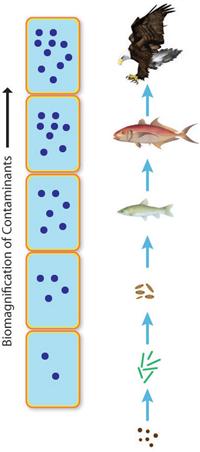Biomagnification

Biomagnification is the process by which toxic chemicals build up within predators. This typically occurs across an entire food chain and affects all of the organisms but animals higher up in the chain are more impacted.[2] When predatory animals consume their prey they also consume all of the toxic chemicals within said prey. When these toxins aren't easily excreted they build up in the animal's system through bioaccumulation. Therefore, when the food chain progresses, concentrations increase or magnify. Biomagnification can be considered the result of bioaccumulation.
Example
At the bottom of the food chain, plankton are infected with mercury (often through diffusion with the surrounding water) and eaten by some small fish (to greatly simplify things assume that each plankton has a concentration of 1 ppm of mercury in it). Each small fish consumes ten times their weight in plankton over a period of time. The fish would now have 10 ppm of mercury in their system. Now those small fish are eaten by a school of larger fish who consume ten times their weight each, the larger fish would now have 100 ppm of mercury in their system. This process continues all the way up the food chain to animals like humans and eagles (animals that are not usually eaten by other animals) where concentrations of the toxin reach their highest and the health dangers are the greatest.
For Further Reading
Reference
- ↑ Nile RAK 2007 internet: http://nilerak.hatfieldgroup.com
- ↑ D. Mackay and a. Fraser, “Bioaccumulation of persistent organic chemicals: mechanisms and models,” Environmental Pollution, vol. 110, no. 3, pp. 375–391, Dec. 2000.

